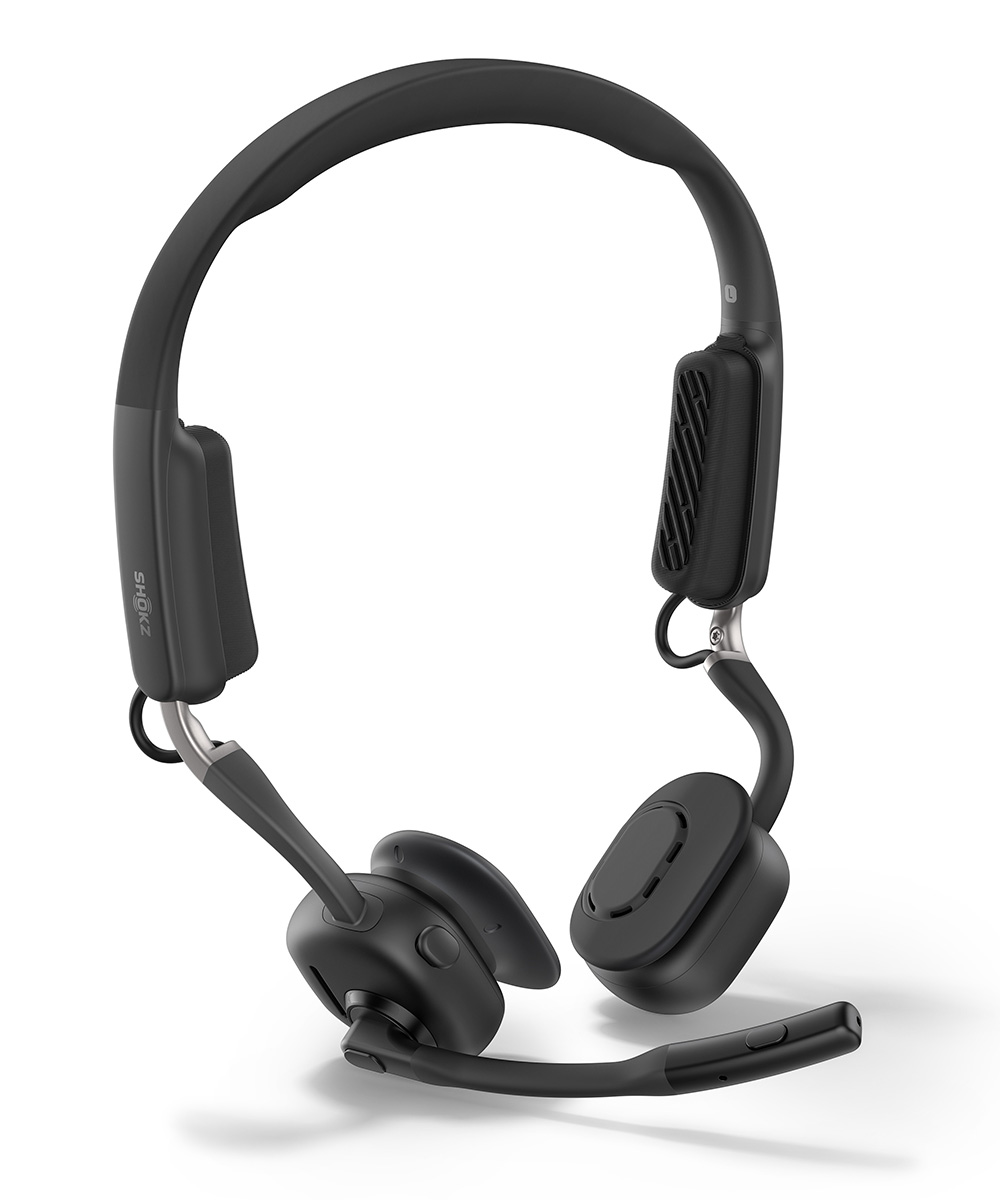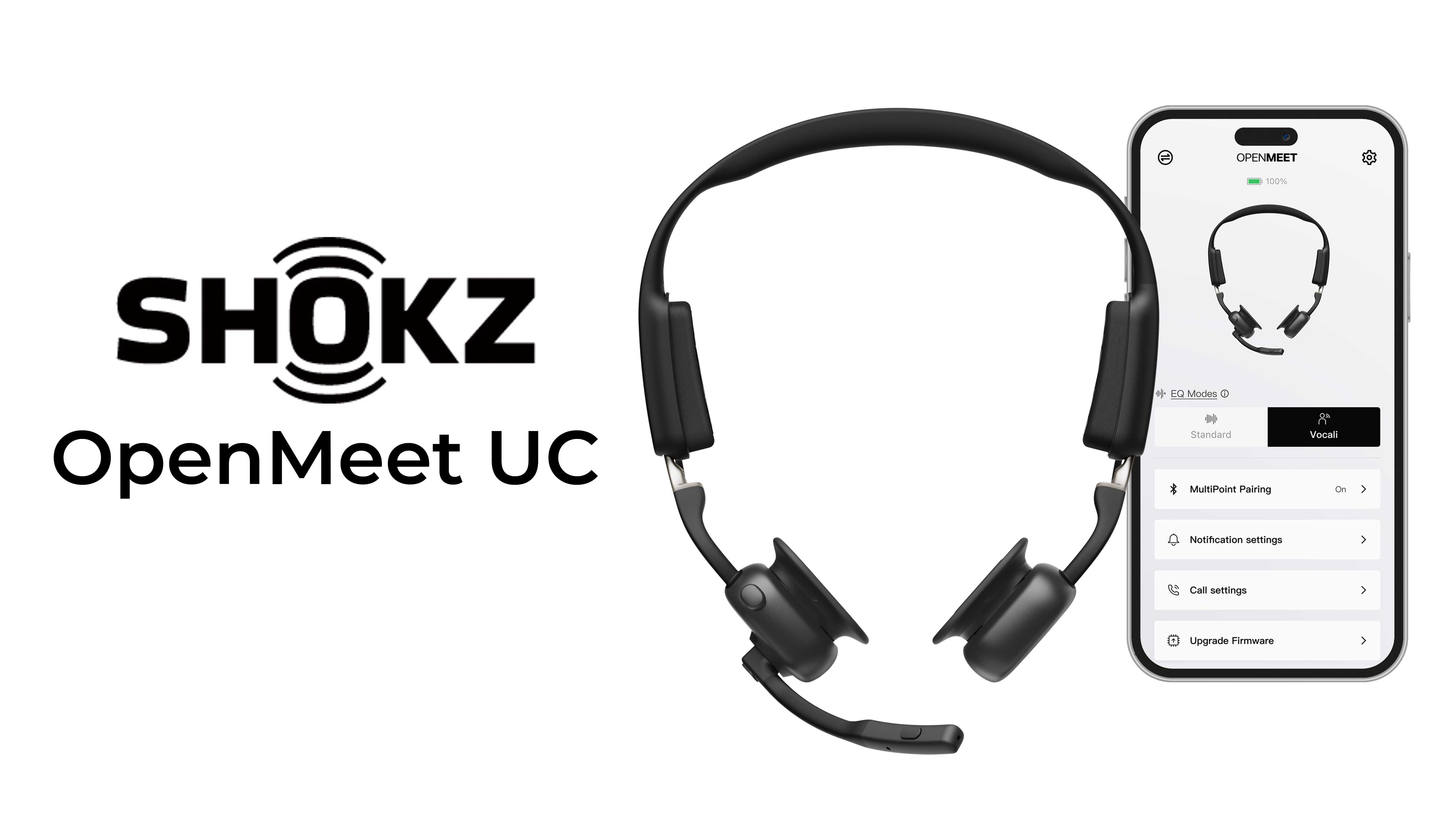The OpenMeet UC introduces a new overhead form factor to Shokz's product line of earbuds and wraparound headphones. Like its predecessors, the OpenMeet UC delivers sound via bone conduction technology, which means you don't actually put anything inside or around your ears. Instead, the headset comfortably sits in front of your ears, transmitting sound using vibration through the bones in your skull.
Let's Get Comfortable
What makes the OpenMeet UC different is that it more closely resembles a traditional headset, with a headband that rests on top of your head. According to Shokz, it features TitaniumFlex technology, a five-point design with flexible titanium plates. As a result, the headpiece is incredibly bendy and adjustable, so it should accommodate any head short of a Klingon noggin that attempts to use it. That said, unlike other Shokz models, this headset is definitely not for use during exercise.
[SCN Review: Insta360 Is Following the Action]
So, what's in the box? Besides the headset and some product/warranty info, Shokz provides two extra sets of pressure relief cushions, plus a storage case, USB wireless adapter for your computer, and USB-C cable. Yes, the larger headset means more real estate, so Shokz has replaced its proprietary charging port with the far more universal USB-C option.
The pressure relief cushions cover the parts of the headset that sit in your hairline close to your temples. You have three choices of thickness; the cushions are attached via Velcro, so you can easily test them to find the fit that's right for you. Honestly, I didn't feel much difference, so I settled on medium.
Let's take a moment and discuss the case. It almost feels like a fuzzy piece of hard-sided luggage, and a zipper pull tab makes it easy to open. There is a separate and secure home for the USB-C wireless adapter, plus a Velcro strap that holds your USB-C charging cable in place. The headset itself sits criss-cross in place, with an indented area that provides a little extra protection for the power button. Smart design.
Reasons to Upgrade
No matter your affinity for luggage, you're not buying the OpenMeet UC for its case, so why should workers make the jump from the OpenComm product line to the OpenMeet form factor? There are a few compelling arguments. First, it provides the more professional "look" of a headset without being too bulky. Like other Shokz offerings, it's very lightweight, so it's not a burden to wear this headset for hours at a time. That's important, because lack of comfort is (forgive me) a pain point among headset users.
Another useful feature is the LED indicator light above the mic boom arm, which essentially serves as a mini "do not disturb" sign. The light does not turn on when you're streaming video or listening to music, but it turns red when you're on a call or videoconference. It also provides other information, such as an incoming call (flashing green) or low battery (flashing red).

Third, and arguably most important, is the sound. The OpenMeet UC provides a dramatic improvement over the wraparound models I've tested. The fuller aural experience is likely the result of significantly improved bass (and I'm guessing that's why the new headset's earpieces are larger and heavier).
[Shure Product Review: Premium Podcasting with the MV7+]
That's not to say the other products sound bad, but the biggest knock on bone conduction headsets has been weak bass performance. You're not going to replace your favorite over-the-ear headphones with the OpenMeet UC for critical listening in post, but it will deliver very satisfying audio in the office.
The other criticism with bone conduction is the vibrating sensation; some people are more sensitive to it than others. But it's been tamped down considerably with the OpenMeet UC at moderate volume, though you can still feel the sensation if you decide to play your music loudly.
Other Considerations
The OpenMeet UC's USB wireless adapter is designed to deliver improved stability over a simple Bluetooth connection. Being the unreasonable reviewer that I am, I decided to test this to the extreme. I queued up "She's So Young" from The Pursuit of Happiness on YouTube and took a walk around the inside of my house. Then, I walked to the mailbox and kept going.
I didn't experience an audio dropout until I was across the street and one house over. For comparison, I tried the same experiment with my OpenComm UC headset from 2023 and barely made it to the property line before the dropouts started. Both headsets are rated for 98 feet, but clearly Shokz has made some improvements. The Bluetooth connection to my iPhone delivered similar results.

The OpenMeet UC will also help you sound great. I tried it on both cell phone calls and videoconferences, and the general consensus was that I sounded crystal clear. Though it cannot be rotated for use on the left side of your face, the boom mic offers more than 130 degrees of positioning. The headset mic is equipped with Qualcomm's cVc noise reduction algorithm, but it's not perfect. When I crinkled paper near or somewhat near the mic, it was loud and clear on phone calls. Wind was also a problem when I walked outside while on a call.
Some conferencing platforms like Google Meet have their own noise-cancellation technology, which can be a big help. Of course, there's also a built-in mute/unmute button on the mic arm, so it's easy enough to silence your side of the conversation if you're in a disruptive environment.
You don't absolutely need it, but the free Shokz app (available for Android and iOS) adds additional functionality. Arguably the most significant feature is the EQ. You can choose between standard and vocal—I preferred the enhanced mids of the vocal setting—but you can also upgrade firmware, adjust notifications, and personalize other settings.
[SCN Review: Logitech Going Beyond Good Enough]
Priced at around $250 ($220 without the USB wireless adapter), is the OpenMeet UC right for you? It really depends on your workspace. If you're in a loud office, the headset won't block out unwanted noise. However, if you constantly find yourself removing your headset to interact with those around you or feel more connected to your surroundings, this could be a godsend. Plus, the OpenMeet UC delivers the performance you need for all-day use, with battery life to spare (up to 14 hours of talk time), intuitive controls, lightweight comfort, and the best bone conduction audio I've experienced to date.

